Il grigliato FRP, noto anche come grigliato in plastica fibrorinforzata, si è imposto come materiale versatile e durevole in diverse applicazioni industriali. La sua composizione unica e le sue proprietà intrinseche lo rendono una scelta ideale per un'ampia gamma di ambienti, compresi quelli che richiedono un'elevata forza, resistenza alla corrosione e isolamento elettrico. Questo articolo esplora i vantaggi, le applicazioni e la guida all'installazione del grigliato FRP, fornendo una comprensione completa dei suoi vantaggi e del suo utilizzo pratico.
Il vantaggio principale del grigliato in FRP è il suo eccezionale rapporto resistenza-peso. A differenza dei materiali tradizionali, come l'acciaio o il cemento, il grigliato in FRP è molto più leggero, pur mantenendo un'elevata resistenza alla trazione. Questa caratteristica ne facilita il trasporto e l'installazione, riducendo il costo complessivo del progetto. Inoltre, la leggerezza del grigliato FRP riduce al minimo il carico sulle strutture di supporto, rendendolo adatto all'uso in ponti, passerelle e soppalchi dove il peso è un fattore critico.
La resistenza alla corrosione è un'altra caratteristica distintiva del grigliato in FRP. A differenza dei grigliati metallici, che possono arrugginire e degradarsi nel tempo se esposti ad ambienti difficili, i grigliati in FRP non vengono intaccati da sostanze chimiche, acqua salata e umidità. Ciò lo rende una scelta eccellente per le applicazioni in ambienti marini, di lavorazione chimica e di trattamento delle acque reflue. La capacità di resistere agli elementi corrosivi senza deteriorarsi garantisce una maggiore durata e riduce la necessità di frequenti interventi di manutenzione e sostituzione.
L'isolamento elettrico è una proprietà fondamentale del grigliato FRP, che lo rende ideale per l'uso in ambienti in cui la sicurezza elettrica è fondamentale. Il grigliato FRP non conduce l'elettricità, evitando così cortocircuiti e rischi elettrici. Questa caratteristica è particolarmente importante nelle sottostazioni elettriche, nelle centrali elettriche e negli ambienti industriali dove i macchinari e le attrezzature sono soggetti a scariche elettriche. La natura non conduttiva del grigliato FRP fornisce una piattaforma sicura e affidabile per i lavoratori e le attrezzature.
Il grigliato FRP è ampiamente utilizzato nelle applicazioni di pavimentazione industriale. La sua durata e resistenza ai carichi pesanti lo rendono adatto all'uso in corsie per carrelli elevatori, banchine di carico e aree per macchinari pesanti. La capacità del materiale di distribuire uniformemente il peso evita i cedimenti e garantisce una superficie stabile, anche in condizioni estreme. Inoltre, i grigliati in FRP possono essere personalizzati per soddisfare requisiti di progettazione specifici, tra cui spessori diversi, texture superficiali e capacità di carico.
Oltre che nelle pavimentazioni industriali, il grigliato in FRP è comunemente utilizzato anche nella costruzione di ponti e passerelle. Il suo design leggero consente una facile installazione e riduce la necessità di strutture di supporto aggiuntive. La resistenza alla corrosione del materiale garantisce che i ponti e le passerelle costruiti con il grigliato in FRP rimangano durevoli e sicuri nel tempo, anche se esposti a condizioni climatiche e ambientali difficili.
L'installazione del grigliato in FRP è relativamente semplice e può essere effettuata con strumenti e attrezzature minime. I pannelli di grigliato sono in genere preassemblati e consegnati in cantiere, pronti per l'installazione immediata. Questo design modulare semplifica il processo di installazione e riduce i costi di manodopera in loco. Inoltre, i grigliati in FRP possono essere installati su superfici esistenti, come ponti in cemento o in acciaio, senza la necessità di effettuare modifiche o preparazioni estese.
Per garantire prestazioni ottimali e una lunga durata, è essenziale seguire le linee guida del produttore durante l'installazione. Un ancoraggio e un supporto adeguati sono fondamentali per evitare spostamenti o movimenti del grigliato. Inoltre, l'uso di sigillanti e rivestimenti appropriati può migliorare ulteriormente la durata e la resistenza del grigliato FRP ai fattori ambientali. Si raccomanda inoltre di effettuare ispezioni e manutenzioni regolari per identificare e risolvere qualsiasi problema potenziale prima che si aggravi.
In conclusione, il grigliato in FRP offre numerosi vantaggi che lo rendono una scelta superiore per un'ampia gamma di applicazioni industriali. L'elevato rapporto forza-peso, la resistenza alla corrosione e le proprietà di isolamento elettrico ne fanno un materiale ideale per ponti, passerelle, pavimentazioni e altre strutture. La facilità di installazione e i bassi requisiti di manutenzione ne aumentano ulteriormente l'attrattiva, rendendo il grigliato in FRP una soluzione economica e affidabile per diverse esigenze industriali. Comprendendone i vantaggi e le corrette tecniche di installazione, le aziende possono sfruttare i benefici del grigliato in FRP per migliorare la sicurezza, la durata e l'efficienza delle loro attività.







